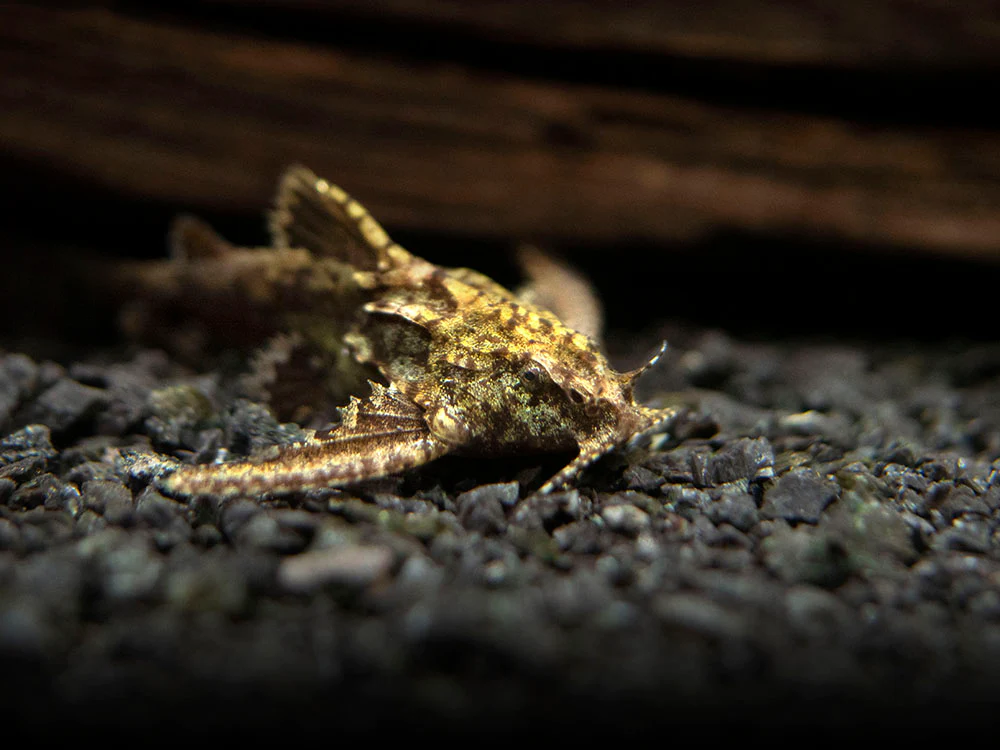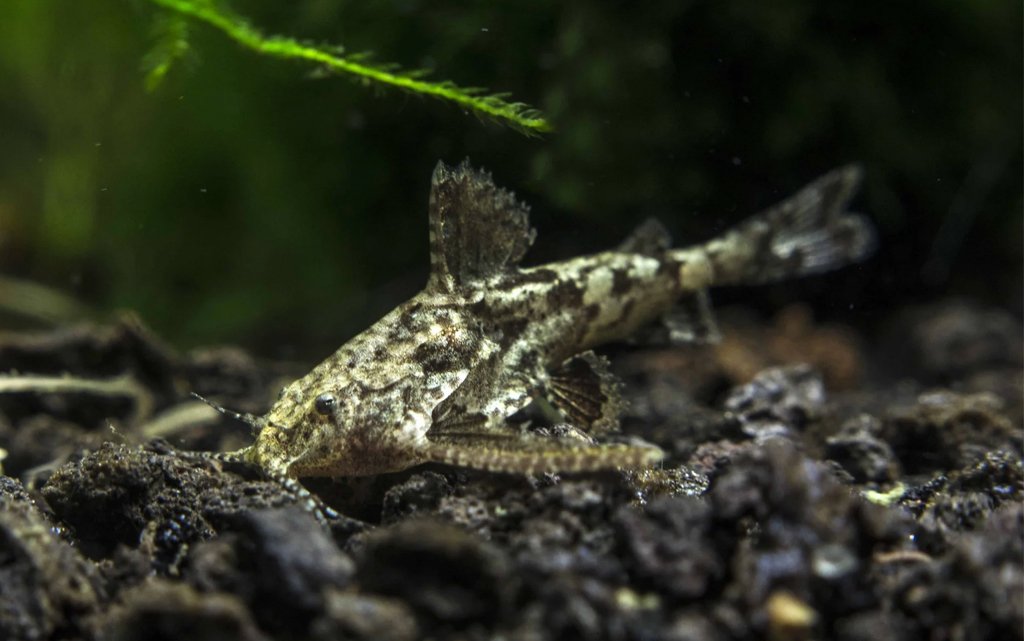Asian Stone Catfish
The Asian Stone Catfish, Hara jerdoni, also known as the Dwarf Stone Catfish, is a small freshwater fish native to the slow-moving waters of India and Bangladesh.
This petite species is a favorite among aquarium hobbyists due to their manageable size and peaceful disposition.
- Experience Level: Intermediate
- Hardiness: Hardy
- Minimum Tank Size: 10 gal (40 L)
- Maximum Size: 2 inches (5 cm)
- Temperament: Peaceful
- Temperature: 65 – 75° F (18 – 24° C)
- pH Range: 5.6 – 7.5
- Water Hardness: 8 – 15 dGH
- Diet: Omnivore
Table of Contents
Introduction
Size and Appearance
Care Guide
Tank Mates
Diet and Feeding
Breeding
The Asian stone catfish holds a captivating allure among hobbyists, mainly due to its unique, extended pectoral fins, which allow the creature to anchor itself into small crevices in the water. From a bird’s eye view, this feature gives it an anchor-like appearance, hence its alternate name, the dwarf anchor catfish.
Known for their tranquility, these fish integrate well into community aquariums. Before deciding to incorporate them into your tank, however, it is helpful to be aware of some key information regarding the proper care for these delicate creatures.
Size and Appearance
The Asian stone catfish holds a captivating allure among hobbyists, mainly due to its unique, extended pectoral fins, which allow the creature to anchor itself into small crevices in the water. From a bird’s eye view, this feature gives it an anchor-like appearance, hence its alternate name, the dwarf anchor catfish.
Known for their tranquillity, these fish integrate well into community aquariums. Before deciding to incorporate them into your tank, however, it is helpful to be aware of some key information regarding the proper care for these delicate creatures.
The Asian stone catfish grows to a maximum length of 5 inches, making it an agreeable option for small, or “nano,” aquariums that hold a minimum of 3 gallons of water.
Contrary to other fish species, these catfish prefer to be stationary, mainly due to their nocturnal habits. Nevertheless, there are essential preparations to make before purchasing any dwarf anchor catfish for your aquarium.
Care Guide
- Minimum Tank Size: 10 gal (40 L)
- pH Range: 5.6 – 7.5
- Water Hardness: 8 – 15 dGH
- Temperature: 65 – 75° F (18 – 24° C)
- Lighting: Low to Moderate, diffused lighting
- Substrate: Sand/gravel ideal
- Brackish: No
- Water Flow: Weak/Low
- Tank Region: Bottom
Asian stone catfish aren’t considered active swimmers, thus, a 10-gallon aquarium can comfortably accommodate a small group of them. Despite their preference for small tanks, maintaining proper water conditions is critical for the welfare of these catfish. This includes maintaining a stable temperature between 65 – 75° F (18 – 24° C) and a pH level of 5.6–7.5. Water hardness should also be observed and kept moderate.
In captivity, these fish need highly filtered, richly oxygenated, and calm water to survive. An inadequate oxygen supply or a spike in nitrate levels can prove disastrous for this species and can potentially cause them to molt.
Given the Asian Stone catfish’s predilection for dwelling at the bottom of the tank, they are susceptible to bacterial and fungal infections. Therefore, the substrate should be regularly vacuumed to maintain sanitation. Extra caution is needed during this process, as these fish camouflage themselves into the sandy bottom of the tank.
Asian stone catfish thrive in mild water currents with sandy environments. Feeling secure is crucial for this nocturnal species, so providing them with a safe habitat within your tank is vital. This can be accomplished by creating a habitat within the tank that mimics their natural living conditions. Decorative components should include:
- A Sandy Substrate
- A scattering of small stones or light gravel
- An abundance of Java moss, fern, and baby grass
- A carpet of dried oak and beech leaves to simulate their natural habitat
- Arrangements of driftwood, rocks, and pieces of bamboo
- Surface plants or a dim lighting setup
It is essential to provide an abundance of hiding spaces for these solitary creatures in addition to maintaining perfect water quality, as this will help to recreate a suitable natural habitat.
Tank Mates
Asian stone catfish are a harmonious species, making them well-suited for community tanks. They tend to prefer the company of their own kind, but they could share an environment with similar small species in a biotope setup.
It’s important to note, however, that active bottom-dwellers should be avoided for these quiet fish, as they could interfere with their ability to compete for food. The diminutive Asian stone catfish pairs well with several other peaceful fish species and invertebrates that require similar water conditions and are roughly the same size.
The most suitable tank mates for the Asian stone catfish include:
- Celestial Pearl Danios
- Golden Dwarf Barbs
- Scarlet Badis
- False Harlequin Rasboras
- Mosquito Rasboras
- Farlowellas
- Other peaceful Indian fish
- Cloud Minnows
- Adult Dwarf Shrimp
It is recommended that the dwarf anchor catfish should be the only bottom-dweller in the tank to prevent unnecessary tension.
Feeding Guide
- Diet: Omnivore
- Frequency: 1 – 2 small feedings per day
- Pellet Foods: Yes
- Flake Foods: Yes
- Live Foods: Yes
- Meat Foods: Yes
- Vegetable Foods: Yes
Considering their reclusive nature, it shouldn’t surprise you that the dwarf anchor catfish tends to be rather inconspicuous in the tank during daytime hours. These nocturnal creatures typically seek food under the cover of darkness.
A typical Asian stone catfish diet mirrors the foods readily available in their native environments—primarily live or frozen varieties such as daphnia, cyclops, brine shrimp, and bloodworms. After adjusting to life in an aquarium, the omnivorous catfish will also readily accept dried food pellets and algae wafers.
Dwarf anchor catfish are not picky eaters. You may frequently observe them rummaging through the substrate and leaf litter for remnants of uneaten food. Feed them once or twice a day to avoid overfeeding them.
Breeding
While some aquarium enthusiasts consider breeding Asian freshwater fish to be a challenging endeavor, others find it to be a straightforward process. Breeding the Asian stone catfish in captivity is possible, but caring for egg layers can require extra attention.
To assist you in understanding how to successfully breed Asian stone catfish, follow these sequential steps:
- Set up a separate breeding tank, outfitted with spawning mops, Java moss, or baby grass.
- Introduce 4 to 5 adult Asian stone catfish into the new tank for mating. Females can be identified by their fuller bodies and inward-curving pectoral fins, whereas males have longer fins and barbels. An optimal sex ratio would be two males for every three females.
- Prepare the potential breeders by feeding them live food for several days before spawning.
- Regularly change about 30% of the water every 4 to 5 days to reduce nitrogenous waste levels in the breeding tank. Additionally, a sponge filter may help to keep the water oxygenated, clean, and stagnant.
- Shortly after spawning, fertilized eggs can typically be found amongst the Java moss or baby grass.
- Despite the Asian stone catfish’s tendency to avoid eating their fry, it is advisable to separate the adults from the breeding tank to ensure special care for the vulnerable newborns.
The key factors to consider in breeding these egg-laying fish include the water quality, temperature, lighting, and foliage in the breeding environment.



